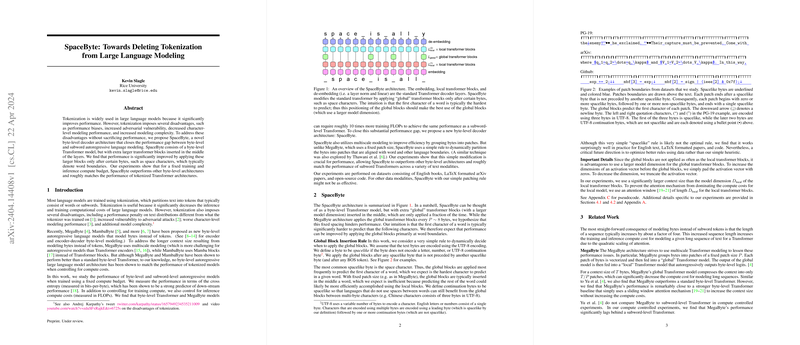SpaceByte: Introducing a Novel Byte-Level Decoder Architecture for Efficient LLMing
Introduction to SpaceByte
SpaceByte represents a significant advancement in LLMing, particularly in addressing the inefficiencies inherent in byte-level modeling. Traditionally, LLMs have employed tokenization to segment text into manageable pieces—typically words or subwords. This approach, while effective, introduces several limitations, including model complexity and performance degradation when dealing with text distributions that deviate from the training data.
SpaceByte challenges the status quo by eliminating the need for tokenization, thus simplifying model architecture while maintaining, and in some cases, enhancing performance metrics when compared to tokenized models.
Key Innovations and Findings
SpaceByte innovates primarily in the integration of "global" transformer blocks, which are selectively applied based on character predictability—the primary application being at word boundaries, leveraging the natural linguistic structure of the data:
- Global Block Application: The model introduces a rule to apply global blocks following 'spacelike' bytes—characters that signify transitions or boundaries in text, such as spaces or punctuation. This targeted application aims to optimize resource use by focusing on challenging prediction points.
- Dynamic Byte Grouping: Unlike traditional models that group bytes in fixed sizes, SpaceByte dynamically partitions bytes, aligning groups with linguistic features such as words, drastically reducing the need for larger context windows and thus computation.
Performance Metrics
SpaceByte achieves competitive performance across multiple datasets:
- English books, LaTeX documents, and code: The model shows robust performance, with significant improvements over previous byte-level transformers and equivalence to subword-level transformers in certain metrics.
- Computational Efficiency: By strategically deploying global blocks and dynamically partitioning byte sequences, SpaceByte demonstrates enhanced efficiency, measured in reduced FLOPs (floating point operations) per byte during both training and inference stages.
Comparison with Existing Models
SpaceByte's performance was juxtaposed against several existing models, such as MegaByte and MambaByte, under consistent compute conditions.
- MegaByte: SpaceByte outperformed MegaByte in handling dynamic text sizes and was more adept at modeling complex structures by employing variable-sized byte patches.
- MambaByte: While MambaByte also showed promise in its unique approaches to byte-level modeling, SpaceByte matched or exceeded its performance metrics, particularly in computational efficiency.
Conclusions and Future Work
The introduction of SpaceByte as a viable byte-level LLM opens various avenues for future research:
- Optimizing Insertion Rules: The current heuristic for block insertion, based on spacelike bytes, could be enhanced with more sophisticated, data-driven strategies.
- Multiscale Modeling: Applying this method recursively at sentence or paragraph levels may yield further improvements in modeling long-form texts.
- Integration with Mamba Blocks: Exploring the integration of different types of transformation blocks may lead to further enhancements in both performance and efficiency.
In summary, SpaceByte represents a pivotal shift towards more efficient and simplified LLMing architectures, providing a strong foundation for future innovations in the field. Further examinations and optimizations could not only refine the model's efficacy but also broaden its applicability across more diverse text formats and languages.
